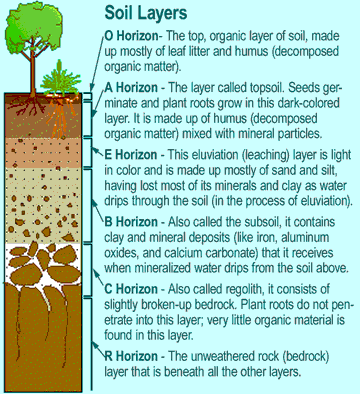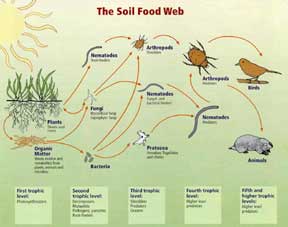Toward a more sustainable Cedar Mill
Soil Basics 101: What is soil made of?
by Donna Prock, permadonna.com
During the 20th century, farmers and gardeners tried out chemical growing—using pesticides and herbicides to combat bugs and weeds and artificial fertilizers to increase yields. Immediate results seemed good, but over the long term, bugs and weeds acquired resistance, and now we are finding out that plants simply aren’t as healthy, and the food isn’t as nutritious, when chemicals are used to grow.
Soil tending is the key to healthy plants in any garden, and to delicious nutritious food in your home plot or grocery basket. Avoid the cascade of unintended consequences with chemical gardening by understanding your soil and building its fertility naturally.
 What is soil made of? What is soil made of?
Soil is formed slowly as rain, wind and friction erode rock (the parent material) into tiny pieces near the Earth's surface. Organic matter decays and mixes with inorganic material (rock particles, minerals and water) to form soil.
Soil is made up of distinct layers called horizons. They range from rich, organic upper layers (humus and topsoil) to underlying rocky layers (subsoil, regolith and bedrock).
About 95 percent of soil consists of minerals. Most of this mineral material has been weathered into very small particles, classified by decreasing size as sand, silt, or clay. Sand includes particles with a diameter smaller than 2 mm but larger than 0.05 mm and feels gritty between your fingers. Silt ranges from 0.05 mm down to 0.002 mm. Pure silt feels smooth and fine like talcum powder. Clay includes anything smaller than 0.002 mm. Pure clay feels very smooth and is sticky when wet. Soils contain a mix of particle sizes, the relative proportions of each determine texture (whether a soil is silt loam, sandy clay loam, silty clay, etc.).
Organic Matter and Humus:
Only three to five percent of soil's total weight is organic matter, formerly living creatures (primarily plants) in various stages of decomposition. You should never underestimate the importance of this once-living material. It must be renewed constantly if the soil is to stay in good condition. It is an important source of phosphorus, nitrogen, and sulfur (major nutrients that plants require), plus the main source of food for microorganisms.
Humus is a term that gardeners use all the time, but that few really understand. It is the product of decomposition of plant and animal residues through the action of microorganisms, a constantly changing chaos teeming with millions of organisms per spoonful. Organic materials are the raw commodities from which humus can be made. It is composed of various decaying plant materials—leaves, dead roots, stems, straw, compost, manure, along with the bodies of microbes, bacteria, and algae living in the soil. True humus is well aged, fine and dark, and decomposed to the point where the original material is no longer recognizable. Yet it's much more resistant to breaking down than is organic matter in earlier stages of decay; some humus lasts many years in the soil. It can restore and maintain the vigor of soil. Its sponginess allows good aeration through the entire profile, and improves the structure. This increases the soil’s capacity for holding moisture and avoiding erosion with leaching-out of nutrients.
Air and Water
When we are standing on the ground it feels pretty solid, but only half of soil is solid particles. The other half is a combination of space (air) and water. When everything is just right, there is plenty of room for air to occupy the space between soil particles. These spaces are known as soil pores. They allow gases such as oxygen and carbon dioxide to move in and out of soil, so that plant roots won't asphyxiate.
When too much water saturates soil, it fills all available air spaces and plant roots can't get any oxygen. Ideally, about half of the “empty” space in soil is filled with water. If present in the right amount, water should encase each soil particle in a thin film of moisture. Chemicals, including plant nutrients, are dissolved in this soil water, often called the soil solution. The only way these vital minerals can move through soil and be absorbed by plants is when they are dissolved in water.
Most plants need an astonishing amount of moisture to keep their cells full and turgid, and plant roots will grow remarkably deep in search of water and nutrients
Soil Structure
If you were to have a choice of soil, which most of us don't, sandy loam is just about ideal. It is light, crumbly, and rich in humus. But no matter what your soil make-up consists of, it can be improved in fairly short order by working in generous helpings of leaves, manure, grass clippings, compost, or other organic matter.
To evaluate a particular soil, consider both its texture and its structure. A soil’s texture refers to the size of the particles that make up the soil. This determines whether you have sandy soil, clay or loam. Structure describes the way these particles are clumped into aggregates, or crumbs. Loose crumbs are good because they increase the soil pore space, and therefore its aeration and drainage. They are held together by humus.
Good structure is far more important than good texture. This is a good thing because texture is something you learn to live with, but structure can be changed. Good structure is something you can create, and it will compensate for any less than ideal texture.
Soil maps are a good tool for identifying the structure of the native soil in your area and can be found at the Web Soil Surveys website: http://websoilsurvey.nrcs.usda.gov/app/WebSoilSurvey.aspx This gives you a base idea of what you may be working with.
According to the map, we have Cascade Silt Loam, blown up from the valley over the millennia; and Cascade Urban Land Complex soils in Bonny Slope, for example. Many people call it clay, but there are very few pockets of true clay in our area. Further down in the Tualatin Valley are areas of deep humus from the many beaver dams that gave Beaverton its name. Some say that the Tualatin Valley has some of the best agricultural soils in the country.
Since there are always variants from site to site, depending on previous gardening practices, and fill dirt from development, you can also perform a simple yet very accurate physical analysis at home to find out the percentages of sand, silt, and clay in the particular soil on your property. Instructions for this test can be found at: http://www.the-compost-gardener.com/soil-texture.html
Loam is composed of an ideal balance of silt, sand, and clay (about 40-40-20% concentration respectively). Loam soils generally contain more nutrients and humus than sandy soils, have better infiltration and drainage than silty soils, and are easier to work than clay soils. Loams are gritty, moist, and retain water easily.
Loam is considered ideal for gardening and agricultural uses because it retains nutrients well and retains water while still allowing the water to flow freely. Loam soil has good tilth and is easy to work over a wide range of moisture conditions.
Different proportions of sand, silt, and clay give rise to types of loam soils: sandy loam, silty loam, clay loam, sandy clay loam, silty clay loam, and loam. A soil dominated by one or two of the three particle size groups can behave like loam if it has a strong granular structure, promoted by a high content of organic matter.
Sandy Soils contain at least 70 percent sand particles by weight, have a gritty texture and are formed from weathered rocks such as limestone, quartz, granite, and shale. If sandy soil contains enough organic matter it is easy to cultivate, however it is prone to over-draining and summer dehydration, and in wet weather it can have problems retaining moisture and nutrients.
Silty soil must contain at least 80% silt particles to be classified as silt. It is considered to be among the most fertile of soils. Usually composed of minerals (predominantly quartz) and fine organic particles, it has more nutrients than sandy soil yet still offers good drainage. When dry it has rather a smooth texture and looks like dark sand. Its weak soil structure means that it is easy to work with when moist and it holds moisture well. These soils are most common in river deltas or areas that were once the bottoms of lakes or ponds.
 |
| click to enlarge |
Soil Biology
“Soil harbors life; it is not life itself” - Chuck Pendergrast
Soil health is defined by its ability to perform essential ecosystem functions such as nutrient cycling, water filtration, and providing habitat for plants and animals. Fertile soil is dark and crumbly and has a rich earthy smell. It holds water like a sponge, breathes air like a lung, and is teeming with life. A gram of healthy soil is home to about 500 million living organisms that make up the soil food web, from the simplest of single-cell organisms such as bacteria, actinomycetes, yeasts, protozoa, and algae, to more familiar multicellular animals such as fungi, nematodes, arthropods, insects, worms, and mammals.
These soil organisms create and maintain a complex warehouse and distribution system capable of storing and moving an abundant yet balanced supply of essential nutrients. When the health of this biology is disturbed by sudden changes to the ecosystem, such as over-tilling or application of any fungicide, herbicide or pesticide chemical, soil health is drastically affected. The biological approach to soil reestablishes soil biology to rebuild the desired properties that bring soil back to good, natural health. The gardener's most important job is to protect and help these creatures by composting; planting cover crops; adding organic soil amendments; paying attention to soil, air, and water contents; and learning other beneficial practices.
For more in-depth information on Soil Biology see http://oregonfoodweb.com/soil-biology/in-depth.html
Next month will feature part two of this article and will focus on soil fertility and sustainable soil management.
|

